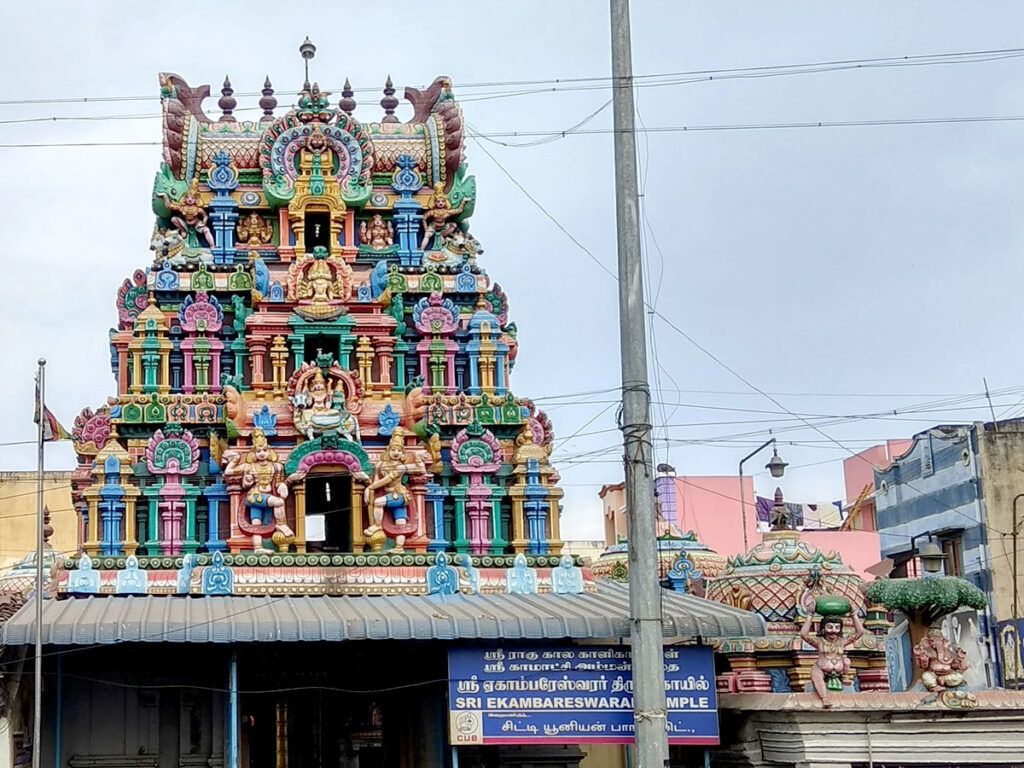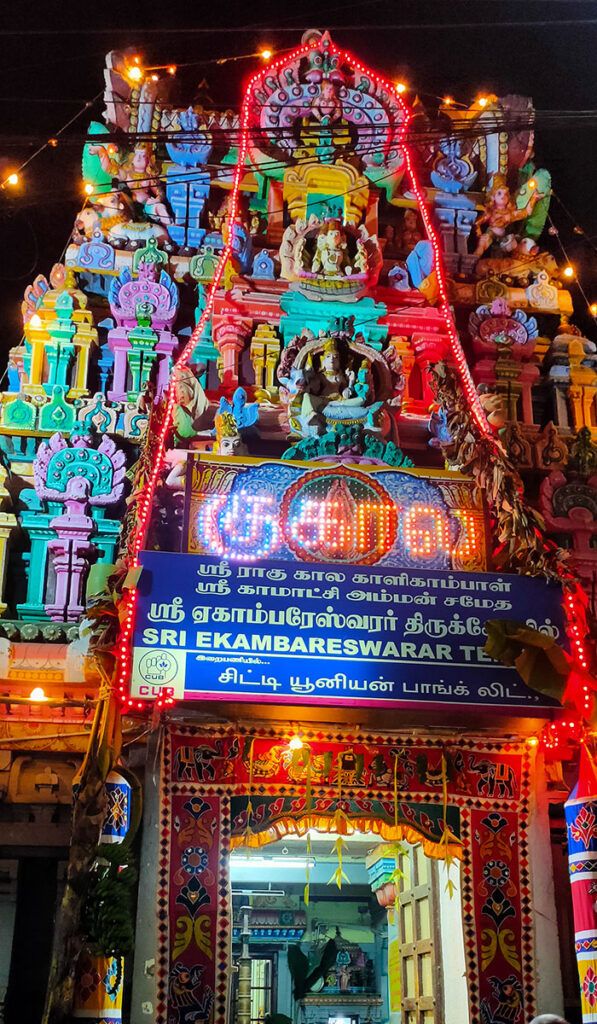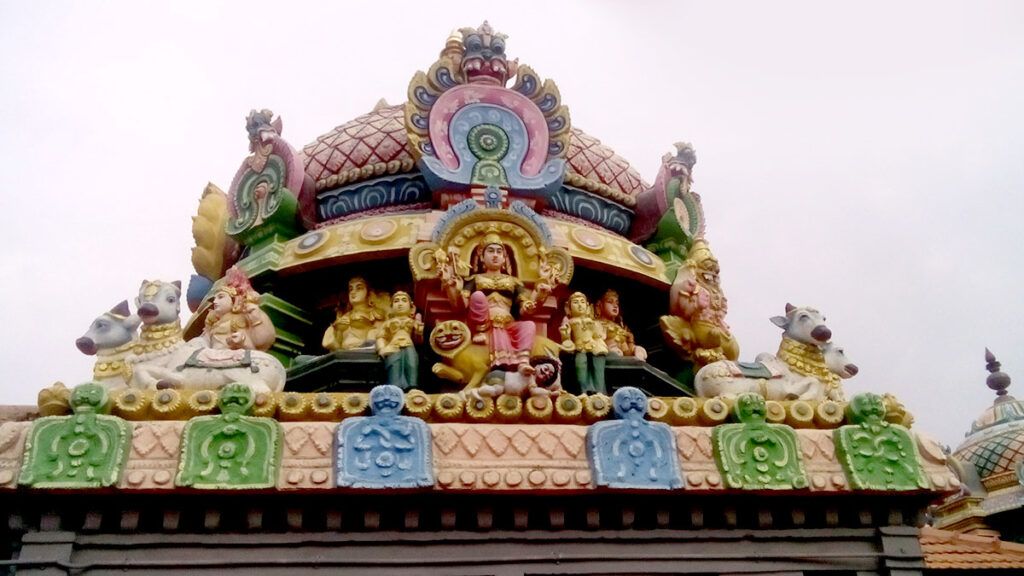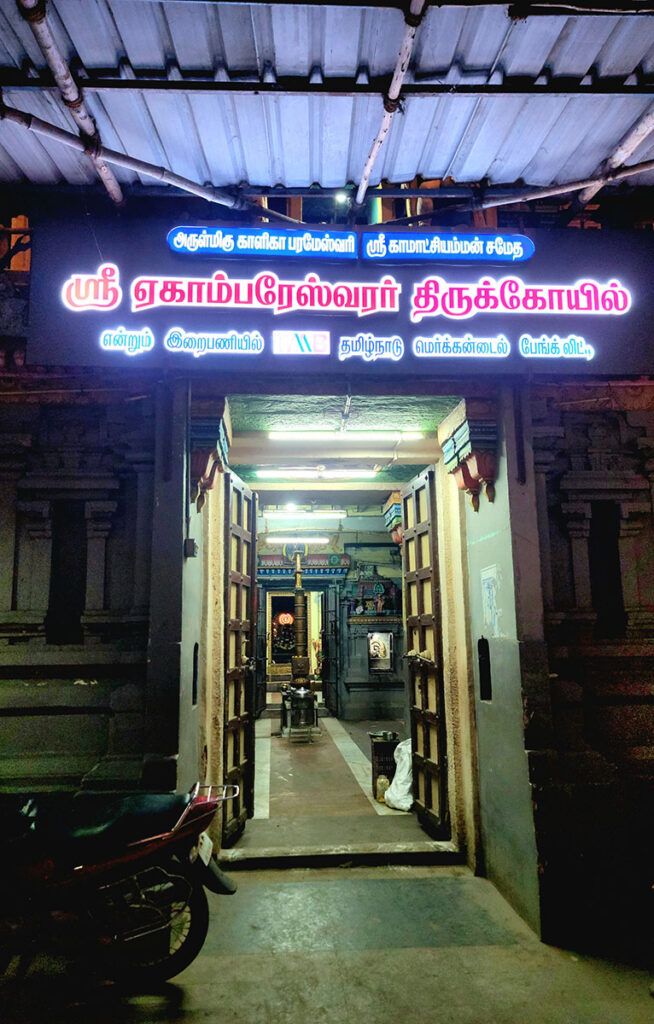Ekambeswarar Temple, Kumbakonam
The Ekambeswarar Temple, also known as the Ekambaranathar Temple, is an ancient Hindu temple dedicated to Lord Shiva located in Kumbakonam, Tamil Nadu, India. It is one of the most important and revered Shiva temples in India.

Contents
- 1 History of Ekambeswarar Temple, Kumbakonam:
- 2 Legend of Ekambeswarar Temple, Kumbakonam:
- 3 Significance of Ekambeswarar Temple, Kumbakonam:
- 4 Myths and beliefs of Ekambeswarar Temple:
- 5 Architecture of Ekambeswarar Temple, Kumbakonam:
- 6 Ekambeswarar Temple Timing:
- 7 Places to visit near Ekambeswarar Temple, Kumbakonam:
- 8 FAQ:
- 9 How to reach Ekambeswarar Temple, Kumbakonam:
- 10 Google Maps:
History of Ekambeswarar Temple, Kumbakonam:
Early History
The earliest historical records of the Ekambeswarar Temple date back to the Chola dynasty, which ruled over the region from the 9th to the 13th centuries. The Cholas were great patrons of the arts and sciences, and they played a significant role in the development of the temple. They constructed many of the temple’s most important structures, including the gopurams (gateway towers) and the mandapams (halls).
Vijayanagara and Nayakkar Eras
After the decline of the Chola dynasty, the Ekambeswarar Temple came under the rule of the Vijayanagara Empire in the 14th century. The Vijayanagaras continued to patronize the temple and made significant additions to the temple complex. They also established the annual Mahamaham festival, which is one of the largest and most important Hindu festivals in South India.
The Nayakkar dynasty, which ruled over the region from the 16th to the 18th centuries, also played a significant role in the history of the Ekambeswarar Temple. They constructed many of the temple’s shrines and mandapams, and they also made generous donations to the temple’s upkeep.
Colonial Period and Modern Times
During the colonial period, the Ekambeswarar Temple was under the control of the British East India Company. The British respected the temple’s religious significance and allowed it to continue to function freely. However, they also made some changes to the temple’s administration, and they imposed some restrictions on Hindu worship.
After India gained independence in 1947, the Ekambeswarar Temple came under the control of the Indian government. The government has since made significant efforts to restore and preserve the temple, and it has also promoted the temple as a tourist destination.
Here are some of the temple’s most notable features:
- The temple’s inner sanctum (garbagriha) houses a lingam, a symbol of Lord Shiva, which is said to be self-manifested.
- The temple complex covers a vast area of 23 acres and is enclosed by a massive outer wall.
- The temple is home to a thousand-pillar hall, known as the Aayiram Kaal Mandapam.
- The temple has a sacred mango tree that is believed to be over 1,000 years old.
- The temple hosts numerous festivals throughout the year, including the Maha Shivaratri festival, the Navaratri festival, and the Karthigai Deepam festival.
Read More>> Panch Kedar Yatra: Ultimate Travel Guide to 5 Divine Shiv Temples

Legend of Ekambeswarar Temple, Kumbakonam:
According to the legend, Parvati was born as a princess named Kamakshi in Kumbakonam. She was a devout devotee of Lord Shiva, and she longed to marry him. One day, she decided to perform a penance to win his love. She went to a mango grove in the town and began to meditate under a sacred tree.
Lord Shiva was impressed by Parvati’s devotion, but he wanted to test her. He sent a fiery inferno to consume the grove. Parvati, undeterred, embraced the lingam, protecting it from the flames. Shiva was so moved by her devotion that he appeared before her and married her.
The lingam that Parvati embraced is the presiding deity of the Ekambeswarar Temple. It is known as the Ekambaka Lingam, or the “one-eyed lingam.” The lingam is made of sand, and it is said to have been created by Parvati herself.
Read More>> Shri Kalabhairaveshwara Temple Bengaluru
Significance of Ekambeswarar Temple, Kumbakonam:
1. Ancient History and Legends:
The Ekambareswarar Temple is believed to have been built in the 7th century CE by the Pallava dynasty. However, its origins are shrouded in legend, with some accounts dating its foundation back to the Treta Yuga, one of the four ages in Hindu cosmology. The temple is associated with several ancient legends, including the story of Lord Shiva’s marriage to Goddess Parvati and the tale of how the temple’s sacred mango tree came to be planted.
2. Architectural Marvel:
The Ekambareswarar Temple is a masterpiece of Dravidian architecture, characterized by its towering gopurams (gateway towers), intricate carvings, and expansive courtyards. The temple complex covers an area of 23 acres and is enclosed by a massive outer wall. The temple’s architectural features, such as its thousand-pillared hall, the Raja Gopuram (the tallest gopuram), and the sanctum sanctorum, are considered to be some of the finest examples of Dravidian architecture in India.
3. Spiritual Eminence and Pilgrimage Site:
The Ekambareswarar Temple is considered one of the most sacred Shiva temples in India and is a major pilgrimage site for Hindus from all over the country. Devotees believe that offering prayers and performing rituals at the temple can bestow blessings, remove obstacles, and promote spiritual enlightenment. The temple is particularly revered during the Maha Shivaratri festival, which celebrates Lord Shiva’s victory over darkness and ignorance.
4. Cultural Heritage and Symbol of Kanchipuram:
The Ekambareswarar Temple has played a significant role in shaping the cultural heritage of Kanchipuram and Tamil Nadu. The temple has been a center of religious and cultural activity for centuries, hosting numerous festivals and celebrations throughout the year. The temple’s architecture, art, and traditions have inspired generations of artists, poets, and musicians, contributing to the rich cultural tapestry of the region.
5. Prithvi Lingam and Pancha Bhoota Sthalams:
The Ekambareswarar Temple is one of the five Pancha Bhoota Sthalams, temples dedicated to Lord Shiva, each representing one of the five primary elements of nature: earth, water, fire, air, and sky. The Ekambareswarar Temple specifically represents the element of earth, or Prithvi. This association with the earth element is further reinforced by the fact that the lingam, the symbol of Shiva, enshrined in the temple is made of earth.
In addition to these five main reasons for its significance, the Ekambareswarar Temple is also notable for its:
- Unique Features: The temple houses several unique features, such as the shrine dedicated to Lord Shiva’s wife, Parvati, the presence of a sacred mango tree, and the annual festival of the thousand lamps, which illuminates the temple complex with a dazzling display of light.
- Symbol of Devotion: The Ekambareswarar Temple stands as a testament to the enduring devotion of Hindus to Lord Shiva. The temple’s continuous upkeep and the unwavering faith of its devotees ensure that it remains a vibrant center of spiritual and cultural life in Kanchipuram.
- Inspiring Setting: The temple’s serene surroundings, with its lush gardens, tranquil ponds, and ancient architecture, create a peaceful and meditative atmosphere that enhances the spiritual experience of visitors.
Read More>> Kotilingeshwara Temple Karnataka: 108 Ft Massive Lingam in the world

Myths and beliefs of Ekambeswarar Temple:
The temple is associated with a fascinating legend involving Lord Shiva and his consort, Goddess Parvati. According to the legend, Parvati, seeking to win Shiva’s love, performed intense penance under a mango tree in this sacred grove. To test her devotion, Shiva sent a fiery inferno to consume the grove. Parvati, undeterred, embraced the lingam, protecting it from the flames. Impressed by her unwavering devotion, Shiva appeared before her and married her. The mango tree under which Parvati performed her penance is still revered in the temple complex.
The legend of the Ekambareswarar Temple is a reminder of the power of love and devotion. It is also a testament to the importance of the Prithvi Lingam, which is said to be a source of great power and blessings.
In addition to the legend, there are a number of other beliefs associated with the Ekambareswarar Temple. One belief is that the temple is a powerful place for healing. Devotees believe that bathing in the temple tank or drinking the water from the tank can cure diseases.
Another belief is that the temple is a place of great wealth and prosperity. Devotees believe that praying to Lord Shiva at the Ekambareswarar Temple can bring them good fortune and abundance.
Read More>> Veerabhadra Swamy Temple Lepakshi: 26Ft Huge Nandi, Hanging Pillar
Architecture of Ekambeswarar Temple, Kumbakonam:
The temple is believed to have been built by the Pallava dynasty in the 7th century AD, and has been expanded and renovated over the centuries by the Chola, Vijayanagara, and Nayak dynasties.
The temple is spread over an area of 23 acres and is enclosed by a massive stone wall. The main entrance to the temple is through the Raja Gopuram, a towering gateway tower that rises to a height of 194 feet. The gopuram is decorated with intricate carvings of Hindu deities and mythological figures.
Inside the temple, the sanctum sanctorum houses the lingam, a representation of Lord Shiva. The lingam is said to have been installed by the sage Markandeya. The temple also has a number of other shrines dedicated to other Hindu deities, including Parvati, Vishnu, Ganesha, and Murugan.
Raja Gopuram: The Raja Gopuram is the main entrance to the temple and is one of the tallest gopurams in India. It is decorated with intricate carvings of Hindu deities and mythological figures.
Pillared Halls: The temple has a number of pillared halls, including the thousand-pillared hall, which is one of the largest pillared halls in India. The pillars are decorated with intricate carvings of Hindu deities and mythological figures.
Tanks: The temple has a number of tanks, including the Shivaganga tank, which is a sacred tank that is said to have been created by Lord Shiva.
Read More>> Ranganathaswamy Temple Srirangam

Ekambeswarar Temple Timing:
Temple timings:
- The temple opens at 6:00 AM and closes at 8:00 PM.
- The temple is closed for an hour from 12:00 PM to 1:00 PM for lunch.
Pooja timings:
- The temple has a daily schedule of poojas that are performed throughout the day.
- The main pooja is the Usha Kala Puja, which is performed at 6:00 AM.
- The other poojas performed in the temple include Kaalasanthi Puja (7:00 AM), Sandhya Kala Puja (6:00 PM), Arathi (7:00 PM), and Sivaratri Puja (on the night of Shivaratri).
Special poojas:
- The temple also has a number of special poojas that are performed throughout the year.
- Some of the special poojas include Mahashivratri Puja, Kumbabhishekam, and Navarathri Puja.
Prayers:
- Devotees who visit the temple offer prayers to Lord Shiva for various blessings.
- Some of the common prayers offered at the temple include prayers for health, wealth, and prosperity.
Dress code:
- Devotees are expected to dress modestly when visiting the temple.
- Men are required to wear a dhoti or shirt and pants, and women are required to wear a sari or a long skirt and blouse.
Donations:
- Devotees are encouraged to make donations to the temple.
- Donations can be made in cash or kind.
Souvenirs:
- The temple has a souvenir shop that sells a variety of items, including religious items, souvenirs, and gifts.
Read More>> Arunachalam Giri Pradakshina: Sacred 8 Lingams of Tiruvannamalai

Places to visit near Ekambeswarar Temple, Kumbakonam:
Sarangapani Temple: This is one of the important Vishnu temples in Kumbakonam and is located close to Ekambeswarar Temple.
Mahamaham Tank: A sacred tank located in the heart of Kumbakonam, Mahamaham Tank is associated with the Mahamaham festival that takes place every 12 years. It’s a serene place to visit.
Adi Kumbeswarar Temple: Another notable Shiva temple in Kumbakonam, it is one of the oldest temples in the town.
Kasi Viswanathar Temple: This temple is dedicated to Lord Shiva and is known for its architectural beauty.
Nageswaran Temple: An ancient temple dedicated to Lord Shiva, known for its architectural splendor.
Uppiliappan Temple: Located in Thirunageswaram, around 7 km from Kumbakonam, this temple is dedicated to Lord Vishnu.
Swamimalai Murugan Temple: It is one of the six abodes of Lord Muruga and is situated a short distance from Kumbakonam.
Chakrapani Temple: A Vishnu temple known for its deity holding a chakra, located in Kumbakonam.
Ayyavadi Pratyangira Devi Temple: This temple is dedicated to the fierce form of the Goddess and is known for its unique deity.
Darasuram Airavatesvara Temple: A UNESCO World Heritage Site, this Chola-era temple is renowned for its intricate carvings and architecture. It’s a bit farther from Kumbakonam but worth a visit.
Kumbakonam Government Museum: If you’re interested in history and artifacts, the museum is a good place to explore.
FAQ:
Which is the famous temple in Kumbakonam?
Kumbakonam, a town in Tamil Nadu, India, is renowned for its numerous temples, each with its own unique history and architectural splendor. Among these, several temples stand out as particularly significant and revered, attracting pilgrims and tourists alike. Here are a few of the most famous temples in Kumbakonam: Kasi Viswanathar Temple, Nageswaran Temple, Airavatesvara Temple, Sarangapani Temple and Adi Kumbeswarar Temple.
Which God is there in Kumbakonam temple?
The majority of the temples in Kumbakonam are dedicated to Lord Shiva and Lord Vishnu. Here are some of the most famous temples in Kumbakonam and the deities they are dedicated to:
Adi Kumbeswarar Temple: This ancient temple is dedicated to Lord Shiva, who is represented by the lingam. His consort Parvati is depicted as Mangalambigai Amman.
Nageswaraswamy Temple: This temple is dedicated to Shiva in the guise of Nagaraja, the serpent king. The temple is one of the oldest Chola temples and is counted as one of the Paadal Petra Sthalams.
Chakrapani Temple: This temple is dedicated to Lord Vishnu, who appears in the form of a discus or Chakra.
Kasi Viswanathar Temple: This temple is dedicated to Lord Shiva, who is also known as Viswanathar.
Ramaswamy Temple: This temple is dedicated to Lord Rama, an incarnation of Lord Vishnu. The temple is known as the southern Ayodhya and is one of the five Vishnu temples that are connected with the Mahamaham festival.
Which temple in Kumbakonam is for marriage?
The most well-known temple in Kumbakonam associated with marriage is the Thirumanancheri Temple, also known as the Sri Kalyanasundareswarar Temple. It is located approximately 35 kilometers from Kumbakonam and is revered as a sacred site for those seeking auspicious unions. The temple’s name itself translates to “marriage temple,” reflecting its significance in marital blessings.
Devotees believe that seeking blessings at the Thirumanancheri Temple can enhance their prospects of marriage, promote harmonious relationships, and foster compatibility between partners. The temple’s presiding deity, Sri Kalyanasundareswarar, is depicted as a groom, symbolizing the divine union between Shiva and Parvati. Worshippers perform special pujas and archanas, offering prayers and rituals to seek blessings for their marital aspirations.
Which temple is famous for curing diseases?
- Vaitheeswaran Kovil: This temple, dedicated to Lord Vaidyanatha, a form of Shiva who is considered the god of medicine, is located in Nagapattinam, about 60 kilometers from Kumbakonam. Devotees believe that praying to Lord Vaidyanatha can bring relief from various ailments.
- Samayapuram Mariamman Temple: This temple, dedicated to Mariamman, a form of Shakti who is considered the protector of children and the healer of diseases, is situated about 20 kilometers from Kumbakonam. Devotees believe that the temple’s sacred water has healing properties and that offering prayers to Mariamman can bring relief from illnesses.
- Kasi Viswanathar Temple: This temple, dedicated to Lord Shiva, is located in Kumbakonam itself. While not specifically known for curing diseases, many devotees believe that the temple’s spiritual atmosphere and the blessings of Lord Shiva can promote overall well-being and healing.
- Adi Kumbeswarar Temple: This ancient temple, dedicated to Lord Shiva, is also located in Kumbakonam. Devotees believe that the temple’s sacred tank, Mahamaham Tank, has healing properties and that bathing in its waters can alleviate ailments.
- Nageswaran Temple: This temple, dedicated to Lord Shiva, is situated about 40 kilometers from Kumbakonam. Devotees believe that the temple’s sacred well, known as the Naga Tirtham, has healing properties and that bathing in its waters can bring relief from skin diseases and other ailments.
How to reach Ekambeswarar Temple, Kumbakonam:
By Air:
The nearest major airport is Chennai International Airport (MAA), which is well-connected to various cities in India and around the world. From Chennai, you can hire a taxi or take a bus to reach Kanchipuram.
By Train:
Kanchipuram has its own railway station, and you can find trains connecting it to major cities in Tamil Nadu and other parts of the country. From the railway station, you can take a taxi or an auto-rickshaw to reach Ekambeswarar Temple.
By Road:
Kanchipuram is well-connected by road, and you can reach the town by bus or car. Several state-run and private buses operate to and from Kanchipuram. If you prefer to drive, you can take the Chennai-Bangalore highway (NH48) to reach Kanchipuram. The town is approximately 75 kilometers southwest of Chennai.
Local Transportation:
Once you reach Kanchipuram, you can hire a local taxi, auto-rickshaw, or use cycle rickshaws to reach Ekambeswarar Temple. The temple is a prominent landmark in the town, and locals can guide you to its location.
